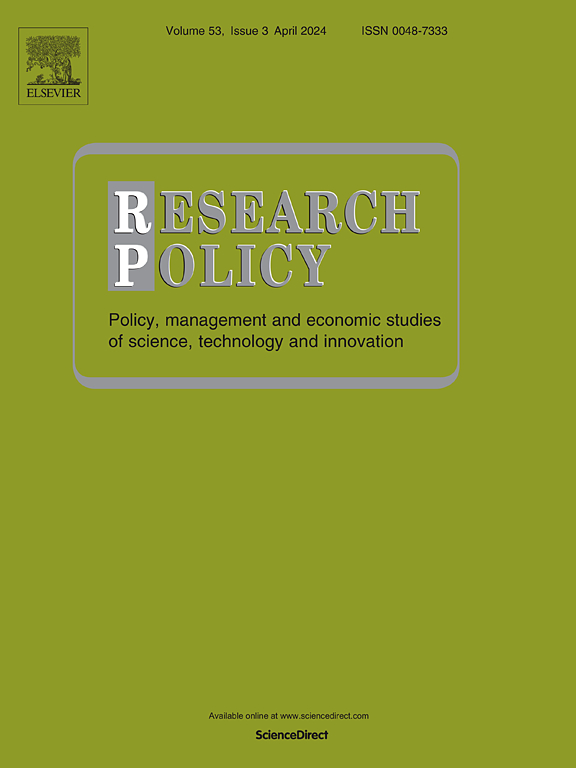文本与引文:专利创新中突破与破坏指标的比较分析
IF 8
1区 管理学
Q1 MANAGEMENT
引用次数: 0
摘要
本研究考察了评估技术创新的两种动态指标——基于文本的突破指数(KI指数)和基于引用的颠覆指数(CD指数),这两种指标都整合了事前(新颖性)和事后(影响)信息。KI指数通过衡量其新颖性(与现有专利相似度低)和影响力(与未来专利相似度高)来确定突破性发明,而CD指数通过分析引用模式的变化来量化技术颠覆性。本文使用1980年至2017年期间向美国专利商标局提交的600多万件专利数据集,发现KI和CD指数高度相关,都有效地反映了技术突破。具有高KI或CD分数的专利通常来自原始的和狭窄的知识库。然而,这两个指数表现出明显的规律:(1)KI指数随经济周期波动,而CD指数则随时间稳步下降;(2) KI指数与未来专利被引影响呈正相关,CD指数与未来专利被引影响呈u型关系;(3)小型和远程团队产生较高的KI但较低的CD分数,可能是因为较大的团队引用较新的,广泛认可的参考文献。我将讨论创新概念——突破、破坏和超越——将这些发现置于背景中,并探讨它们对理解技术进步的影响。这些结果有助于衡量创新的论述,并强调了基于文本和基于引用的方法在评估技术进步方面的互补优势。本文章由计算机程序翻译,如有差异,请以英文原文为准。
Text vs. citations: A comparative analysis of breakthrough and disruption metrics in patent innovation
This study examines two dynamic metrics for assessing technological innovation— the text-based breakthrough index (KI index) and the citation-based disruption index (CD index)—both of which integrate ex-ante (novelty) and ex-post (impact) information. The KI index identifies breakthrough inventions by measuring their novelty (low similarity to prior patents) and impact (high similarity to future patents), whereas the CD index quantifies technological disruption by analyzing shifts in citation patterns. Using a dataset of over six million patents filed with the USPTO between 1980 and 2017, this paper finds that KI and CD indices are highly correlated and both effectively capture technological breakthroughs. Patents with high KI or CD scores typically originate from original and narrowly focused knowledge bases. However, the two indices exhibit distinct patterns: (1) the KI index fluctuates with economic cycles, while the CD index has experienced a steady decline over time; (2) the KI index positively correlates with future patent citation impact, whereas the CD index follows a U-shaped relationship with patent citation impact; and (3) small and remote teams produce higher KI but lower CD scores, potentially because larger teams cite newer, widely recognized references. I discuss innovation concepts—breakthroughs, disruptions, and beyond—to contextualize these findings and explore their implications for understanding technological advancement. These results contribute to the discourse on measuring innovation and underscore the complementary strengths of text-based and citation-based approaches in assessing technological progress.
求助全文
通过发布文献求助,成功后即可免费获取论文全文。
去求助
来源期刊

Research Policy
MANAGEMENT-
CiteScore
12.80
自引率
6.90%
发文量
182
期刊介绍:
Research Policy (RP) articles explore the interaction between innovation, technology, or research, and economic, social, political, and organizational processes, both empirically and theoretically. All RP papers are expected to provide insights with implications for policy or management.
Research Policy (RP) is a multidisciplinary journal focused on analyzing, understanding, and effectively addressing the challenges posed by innovation, technology, R&D, and science. This includes activities related to knowledge creation, diffusion, acquisition, and exploitation in the form of new or improved products, processes, or services, across economic, policy, management, organizational, and environmental dimensions.
 求助内容:
求助内容: 应助结果提醒方式:
应助结果提醒方式:


